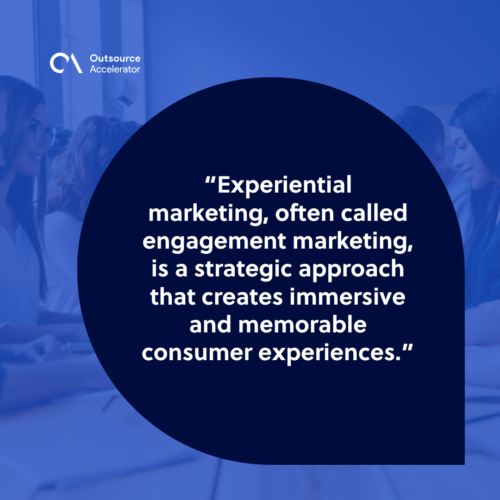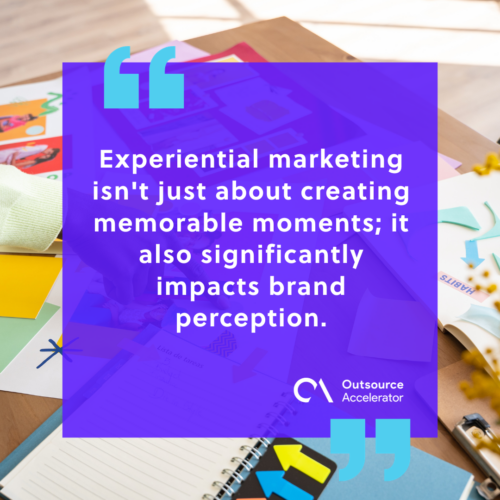A beginner’s guide to experiential marketing

Memorable experiences during purchase and customer interaction create an emotional connection. This makes customers feel valued and understood.
When customers have positive and unforgettable interactions with a brand, they are likely to return for repeat purchases and recommend the business to others. This increases customer retention and helps attract new customers.
Moreover, unique experiences differentiate a business in a competitive marketplace, increasing brand visibility and customer trust.
This is where experiential marketing comes into play, as it provides a structured approach to creating meaningful customer interactions vital for business growth.
Understanding experiential marketing
Experiential marketing, often called engagement marketing, is a strategic approach that creates immersive and memorable consumer experiences.
It deviates from traditional advertising methods that rely solely on conveying messages through various media channels.
Instead, experiential marketing aims to forge a deep and emotional connection between a brand and its target audience.

How experiential marketing works
Experiential marketing leverages the power of firsthand experiences to build brand loyalty and customer engagement.
It invites consumers to actively participate in the brand’s story, offering them a chance to interact with products or services in meaningful and memorable ways.
Adding a personal touch helps consumers to connect emotionally with the brand, increasing the chances of them becoming loyal customers.
Key elements of experiential marketing
Successful experiential marketing campaigns combine these key elements to create a lasting impact:
Immersive experiences
Immersive experiences are at the heart of experiential marketing. Brands create environments or situations that fully engage the senses of their target audience.
This can include pop-up stores, interactive exhibits, or live events where consumers can touch, feel, and tangibly experience the brand.
This experiential marketing element aims to transport consumers into a world that aligns with the brand’s values and message.
Emotional connections
Experiential marketing strives to evoke emotions that resonate with consumers. Whether it’s joy, excitement, nostalgia, or empathy, emotions are powerful tools for creating lasting memories.
Brands aim to establish a genuine emotional connection between consumers and their products or services, ensuring that the brand becomes a part of their personal stories.
Consumer engagement
Active consumer participation is a fundamental aspect of experiential marketing. Brands encourage consumers not only to observe but also to participate in the experience.
This engagement can take various forms, such as:
- Trying out new products
- Sharing experiences on social media
- Using virtual reality
- Collaborating in creative activities related to the brand
These activities empower consumers to feel like co-creators of the brand’s narrative.

How to plan an experiential marketing campaign
Launching a successful experiential marketing campaign requires careful planning and execution.
Here are the essential steps to consider when developing your campaign:
Understand your audience
Understanding your audience is the cornerstone of any effective experiential marketing campaign.
Conducting thorough market research is paramount to gaining insights into customers’ preferences, behaviors, and aspirations. By doing so, you can uncover what motivates and excites them. This will allows you to tailor your campaign to resonate on a deeply personal level.
The more you comprehend your audience, the better equipped you’ll be to craft an experience that leaves a lasting impact.
Conceptualize memorable experiences
The heart and soul of your experiential marketing campaign are the experiences you craft for your audience. It’s where creativity reigns supreme. Your brand’s identity and objectives should fuel brainstorming sessions.
Challenge yourself to think outside the box and devise experiences that align with your brand and have the power to surprise and delight your audience.
Keep in mind that the more memorable the experience, the greater the likelihood of it etching itself into the memories of your audience.
These experiences should evoke emotions, spark engagement, and foster a genuine connection between your audience and your brand.
Choose the right activation channels
Whether hosting a live event, creating a pop-up store, or launching an interactive digital campaign, each marketing channel has its unique strengths and target audience.
Selecting the right channels to deliver your experiential marketing campaign is a strategic decision that can greatly influence its success. Consider which platforms will best convey your message and create the most immersive experience.
Allocate budget and resources
Experiential marketing campaigns can vary significantly regarding the budget and resources they require.
Prioritize elements with the greatest impact and resonate most strongly with your audience. This might include expenses such as venue rental, staff, technology, and marketing materials.
A well-thought-out budget allocation ensures that your campaign achieves the desired level of immersion and engagement without exceeding your financial constraints.
Examples of experiential marketing
To illustrate the power of experiential marketing, let’s explore some notable examples from the world of branding:
Coca-Cola’s “Share a Coke” campaign
Coca-Cola personalized its products by printing common names on soda cans and bottles. This simple gesture encouraged consumers to share a Coke with someone they know, sparking conversations and emotional connections.
Nike’s Free Run trials
Nike invited runners to test their new Free Run shoes on a treadmill set up in a high-traffic area. Passersby could try out the shoes for a quick jog, creating an immediate and immersive experience.
Jollibee’s emotional ads
Jollibee’s “Vow” commercial portrays a touching narrative of a young man who revisits the restaurant, reminiscing about his past love while enjoying a meal.
This heartwarming story not only engages viewers but also creates an emotional connection by evoking feelings of nostalgia, love, and happiness.
Experiential marketing enhances brand perception
Experiential marketing isn’t just about creating memorable moments; it also significantly impacts brand perception.

When consumers have positive and emotionally charged experiences with a brand, they are more likely to
- Develop brand loyalty and advocacy
- Remember the brand and its message for an extended period
Overall, experiential marketing is a powerful strategy for lasting impact on consumers and enhancing your brand’s perception.







 Independent
Independent




